Contact
Department of Aquatic Sciences and Assessment, Division of Environmental Organic Chemistry and Ecotoxicology
Department of Aquatic Sciences and Assessment, Division of Environmental Organic Chemistry and Ecotoxicology

The laboratory analyses persistent organic pollutants (POPs), such as pharmaceuticals, highly fluorinated substances (PFASs), polycyclic aromatic hydrocarbons (PAHs) and flame retardants, found in the environment.
Contact us if you need analysis of environmental or human samples or want to plan research projects with us.
The analytical techniques used are combined liquid chromatography - mass spectrometry (LC-MS) and gas chromatography - mass spectrometry (GC-MS) for target and non-target environmental pollutant analysis at trace and ultratrace levels. We have existing methods for (semi-) persistent organic pollutants, such as traditional environmental pollutants (POPs), pesticides, flame retardants, pharmaceuticals, highly fluorinated substances (PFASs), PAHs,
industrial chemicals, transformation products, etc.
The instrumentation includes GC-MS (Agilent 5975E with EI/CI ionization), GC-MS/MS (Agilent 7010), LC-MS/MS (Thermo-Fischer TSQ Quantiva and SCIEX Triple Quad™ 3500 System) and high resolution MS (LC/GC-QToF -MS; Waters Xevo 2 and Orbitrap Exactive; Thermo ScientificTM). We also have a platform for effect-directed analysis (EDA) with fractionation equipment (FractiomateTM) connected to the Orbitrap instrument and cell-based bioassays for analysis of toxicological responses.
The laboratory is equipped with fume hoods and other equipment for sample preparation and processing of environmental samples (water, sediment, soil, air, biota, etc.) including e.g., high volume water extraction devices (Horizon SPE-DEX 4790), other extraction equipment, homogenizers, centrifuges, ultrasonic baths, etc.